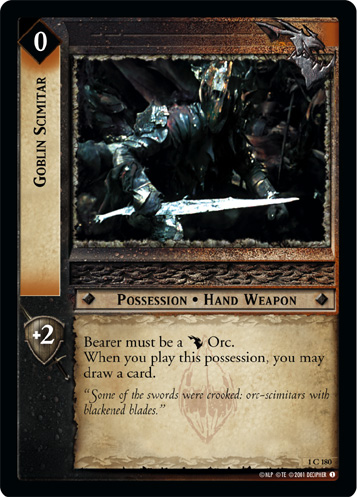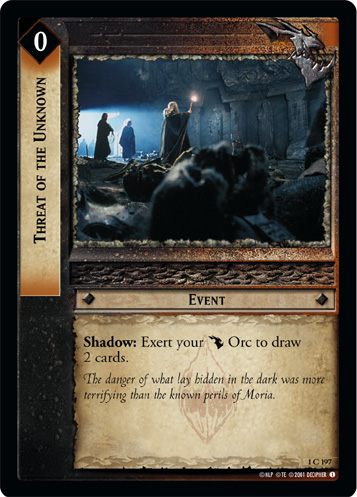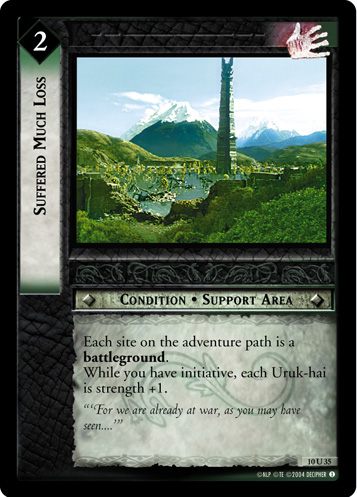PC Errata
The Player's Council is a group of volunteers who aim to nurture and guide the future of the Lord of the Rings TCG. One of the aspects of this responsibility is in issuing card-altering errata to address issues with the game--it's not perfect, after all, and we can always chase the elusive perfect ideal.
History
During the lifetime of the game, Decipher would occasionally issue errata, clarifications, or rulings based on the discovery of a negative interaction in the game (such as infinite loops, overly powerful combos, or what have you). In general, Decipher was only willing to directly change the text of a card (errata) if the problem card was in the most recent set or block--if there was a combo involving an older and a newer card, the solution was typically to add the old card to the X-list, banning it from play.
Occasionally Decipher issued what were essentially errata under different names--"clarifications" if the new text was always the intent of the card and it was just poorly written, and "rulings" if the card touched on a more broad concept that could theoretically affect multiple cards (tho often once the ruling was made, they would avoid making future cards that interact with it just for simplicity's sake).
In all cases however, Decipher attempted to make as few errata, clarifications, and rulings as possible. They knew early on that it's never a good feeling to painstakingly construct a deck from your collection, only to show up to a local event and discover that several of the cards that you built as linchpins have been altered and no longer behave the way they were printed in ink.
PC Era
However, in modern times the landscape of the game has changed. Gemp, the digital platform, dominates in number of games played, with about 6,000 per month in 2021 up to a lifetime peak of more than 10,000. That's an average of 200 games per day in 2021, and more than 330 at peak.
Thus, the PC has opted to take an approach more akin to that used in competitive multiplayer video games, instead. Decipher's approach was understandable for the era in which they worked, but today with the growth of the Internet, the moving of the community into online communities, and the acclimation of players in general to the concept of regular balance patches, the idea of altering large numbers of cards on a regular basis is far more available to us than it was to Decipher. Altering ink is a painful process, but altering pixels is trivial.
Identifying
In Gemp, all errata are indicated by a red line across the upper left-hand corner. In addition, all PC errata have a red box in the lower left-hand corner listing the date that the card was last errata'd.
PC Errata
Below is a list of every errata the PC has issued. These errata apply to all formats with "PC" in the name, including Fellowship - PC, Movie - PC, and Expanded - PC.
X-list Errata
The first batch of errata issued by the PC addressed cards which Decipher had already removed from one or more formats. The reasons are myriad, but the intention of these errata is to bring all such cards to a single more balanced state that can be used in any format the card's set is legal in.
| Card Name | Old Version | PC Errata | Decipher Errata Reason | PC Notes |
|---|---|---|---|---|
Elrond, Lord of Rivendell (1R40)
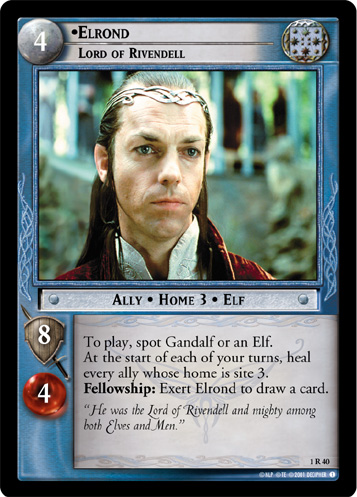
|

|
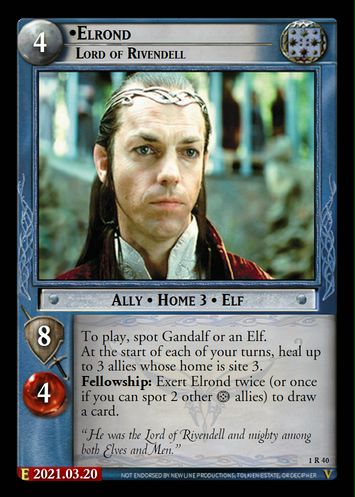
|
The cultural enforcement on this card is not strong enough for the ability provided. Such an ability should require more of a commitment to the 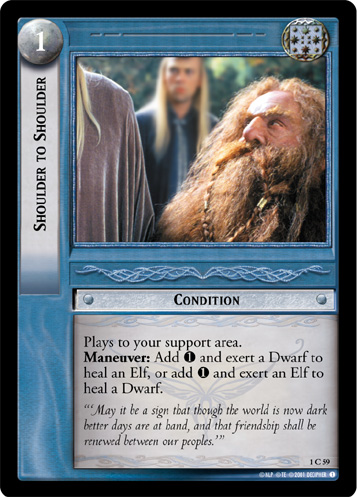 , the healing function of this card provides too much utility, both for Elrond, and other site 3 allies.
, the healing function of this card provides too much utility, both for Elrond, and other site 3 allies.
|
Put a limit on the healing and added additional cultural + strategic enforcement to the card draw. Full article here. |
Sam, Son of Hamfast (1C311)
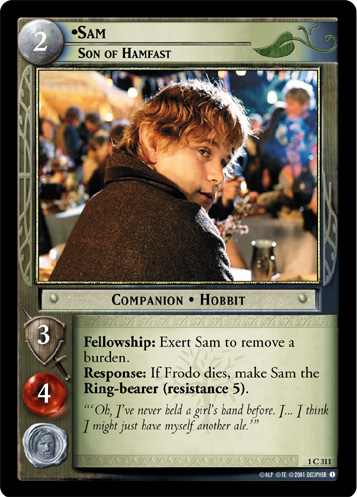
|

|
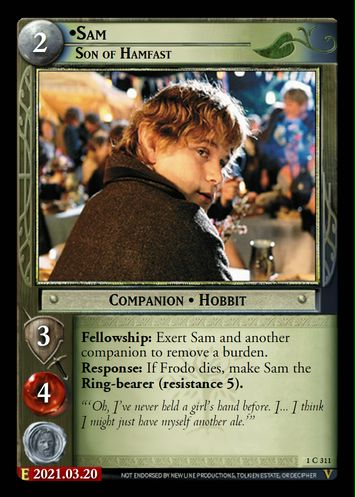
|
This card has been on our X-List radar for quite some time. The deck lists turned in by the top 16 players of each major event this year were a perfect example of why – in every case, at least 15 of them were stocking one or more copies of Sam. He is simply too versatile, offering huge benefits regardless of Free Peoples strategy, and regardless of who your Ring-bearer is. And he’s even better if your Ring-bearer happens to be Frodo.
With Shadows, the need to address Sam became even more pressing. With resistance becoming an important feature of all companions (not just Ring-bearer) and it being directly tied to burdens, Sam easily undermined a large number of Shadow cards in the set, and made many Free Peoples cards too reliable (and thus, too strong). |
Sam is tricky, because not only is he approximately the best burden removal option, for many cultures he represents almost the only burden removal option, as many cultures plain do not have access to native anti-corruption options. Sam probably deserves to be nerfed more than he is, but it's not possible to do so reasonably until other burden options have been added to more cultures in the future. Full article here. |
Flaming Brand (2R32)
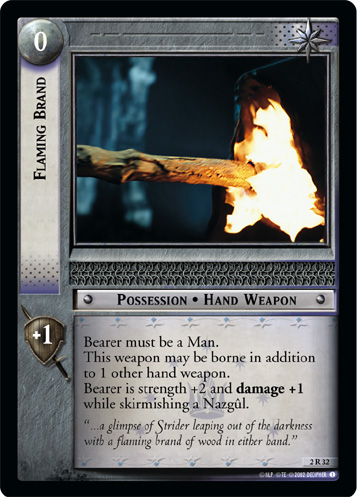
|

|
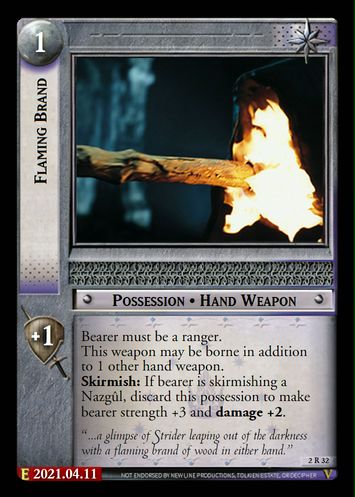
|
This card has no cultural enforcement, may be played in addition to another weapon, and has no cost. The resulting combination provides too much utility. | Full article here. |
Horn of Boromir (3R42)
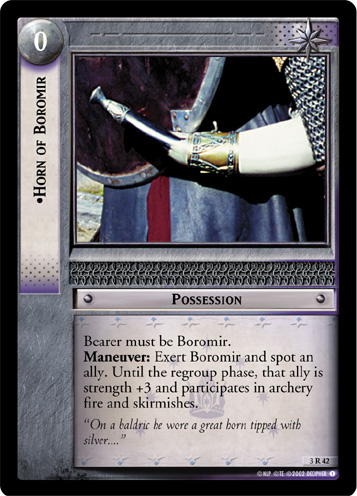
|

|

|
There is no cultural enforcement on the special ability of this card. This permanent effectively circumvents the rule of 9 by allowing non-companions to skirmish. | The permanent Rule of 9 circumvention is the worst aspect of this card. We have started with requiring a discard, so that multiple such usages require multiple backups, but this may prove to be insufficient. If the PC needs to return to this card in the future, it will probably be with a complete rework to the concept. Full article here. |
Saruman, Keeper of Isengard (3R68)

|

|
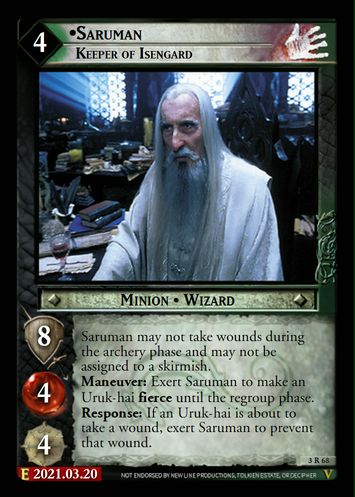
|
This card effectively doubles the number of skirmishes a fellowship faces by making all Uruk-hai fierce and then nullifying play that would serve as protection against those Uruk-hai. | Damage +1 and Fierce are no joke, and TTT's focus on uruks makes Saruman a no-go. By merging both of his abilities to use the same resource pool, the player is now forced to make an interesting decision--keep uruks alive, or keep them fierce? Full article here. |
Galadriel, Lady of Light (1R45)
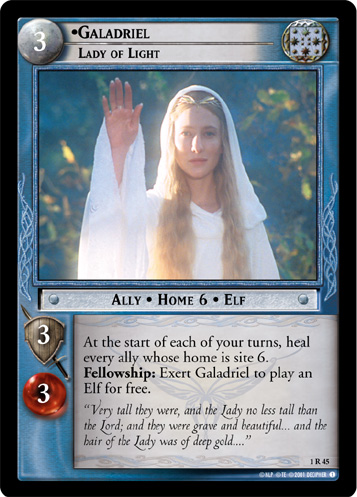
|

|
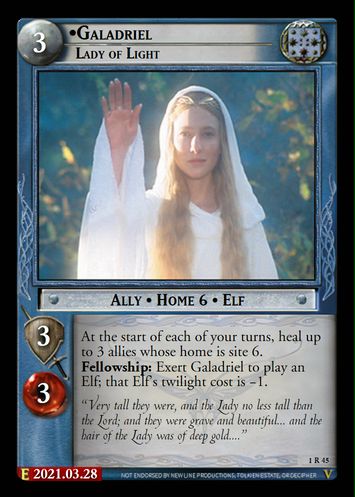
|
This card has no cultural enforcement. The special ability allows a player to play high utility site 6 allies, who also lack cultural enforcement, for free. This level of permanent resource denial undermines the Shadow number curve on sites. Also, when combined with other cards such as Shoulder to Shoulder (1C59)
 , the healing function of this card provides too much utility, both for Galadriel, and other site 6 allies.
, the healing function of this card provides too much utility, both for Galadriel, and other site 6 allies.
|
Galadriel gets the same treatment as Elrond does to her healing ability, and the the twilight discount is reduced to 1. Full article here, 'Choke' section. |
No Stranger to the Shadows (1U108)
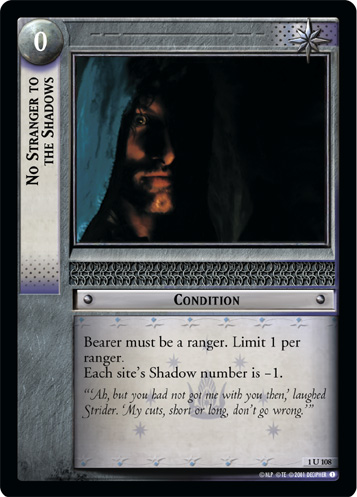
|

|
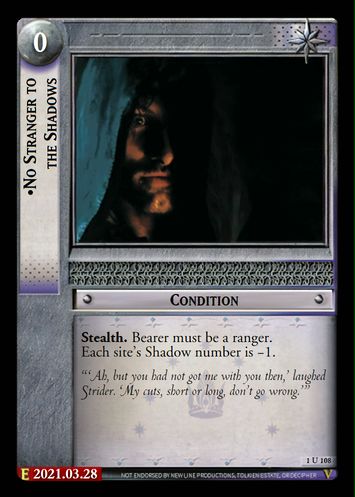
|
This level of permanent resource denial undermines the Shadow number curve on sites. | The card is now unique to limit stacking, and Stealth has been added to potentially allow this card to be targeted in the future. Full article here, 'Choke' section. |
Sting (1R313)
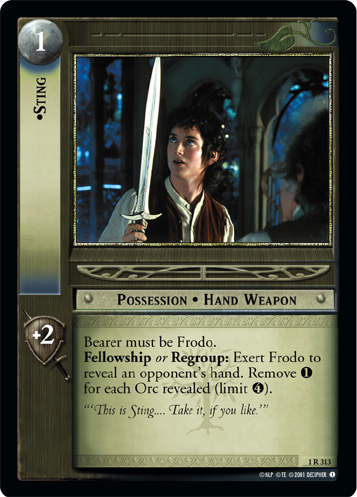
|

|
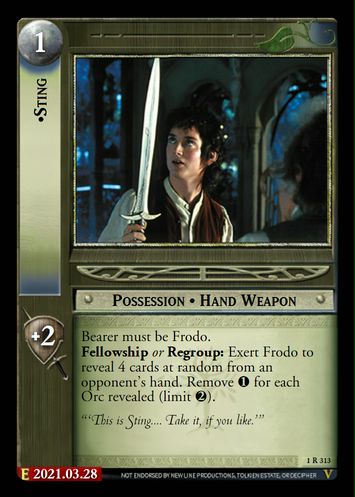
|
There is no cultural enforcement on this card because every deck is required to play with Frodo. This is true of any card that requires only the Ring-bearer with no additional enforcement. The cost of the special ability, exerting a Hobbit, is undercosted for the utility it provides. | Sting was made strictly worse than Glamdring, while also adding a random element to it to make it unreliable. The twilight reduction has also been reduced. Full article here, 'Choke' section. |
A Talent for Not Being Seen (1U316)
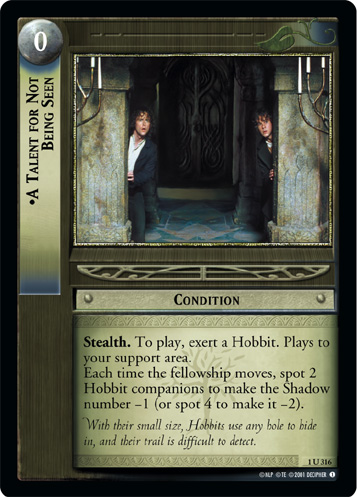
|

|
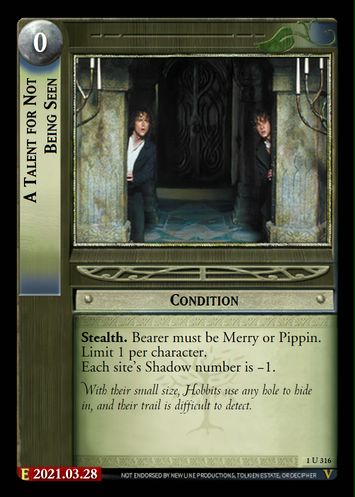
|
Any single type of function of the game can be looked at as falling somewhere on a scale. For example, take healing: on one end of the scale, you have a card which removes 1 wound, while on the other you might have a card which removes 20. Cost is just as important as scope in determining where on the scale a card falls, of course. A card that heals a wound for a twilight cost of 2 is lower on the scale than a card that heals a wound for a twilight cost of 1.
With A Talent For Not Being Seen, the scale in question is denying twilight tokens to the Shadow player. Talent has a very low cost, and over the course of the game it can deny a lot of twilight tokens. Thus its scope leaves us very little room to make cards any better than it without “exploding” this aspect of the game. At the same time, its cost is so low that it leaves us very little room to make cards of lower scope than it – there’s not much lower the cost for such cards can get. It’s sort of a big, rotting tree in the middle of the “twilight denial” acreage. With very limited possibilities for building around it, it had to be torn down to make space for the house we intend to build on the land. For those who feel I’ve stretched my analogy a bit thin (or who draw an unpleasant comparison with Saruman uprooting the forest near Isengard), let me say it another, perhaps simpler way: Talent has been a card near the edge of “trouble” for some time, and with recent efforts to increase the strength of other aspects of the Hobbit culture, it was judged too powerful to remain in the environment. |
Talent's errata aims to preserve the only reason to keep FOTR Pippin alive while working within the very limited constraints that Decipher points out--increasing the exertions or reducing the twilight choke are both low-resolution changes that too easily dumpster the card. Instead, more copies of the card must be included to get the same effect as before. Full article here, 'Choke' section. |
Gimli, Dwarf of the Mountain-race (2P121)
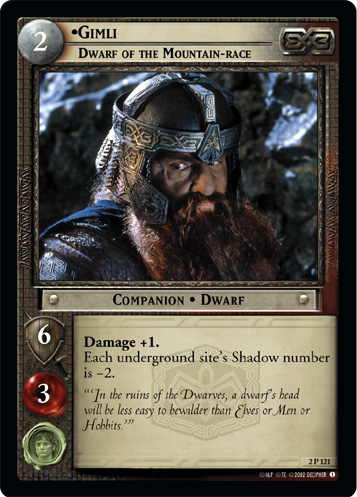
|

|

|
Dwarves as a culture have never excelled at keeping site Shadow numbers low and “choking” off the twilight pool. Gimli was a fun anomaly for the Fellowship block, where the number and placement of underground sites was known and limited. Those same boundaries held true on the Tower and King site paths. But with Shadows, all that is changing.
Shadows has a big focus on what design and development call “terrain” – that is, whether a site is a battleground, forest, mountain, river, or any of the other similar types of keywords. Terrain is so important with the new adventure path that in playtesting, players were frequently bidding to go second, and “pathfinding” (selection of the next site by the Free Peoples player) was valued as it has never been before. If a player wants to run an adventure path of nothing but one type of terrain, that may well be possible – if not with Shadows, then likely once Black Rider and Bloodlines are added to the mix. In short, having a single, easy-to-start card (one with out-of-culture gameplay, at that) which could potentially deny 2 twilight tokens at every single site simply proved too strong. |
Gimli is an odd duck. Rather uniquely among the rest of the cards on this list, he isn’t a problem in FOTR in the slightest. We can of course argue whether the same is true for these other cards, but you can’t deny that most of them have at least been complained about quite loudly and often; the same is not true for Gimli.
Since he is a problem primarily in the post-Shadows world of site manipulation, we are left with reducing his choke impact and granting him an additional bonus to compensate. (It’s probably a moot point anyway, since if you’re playing Dwarves that means Bearer of Grudges, but let no one say we didn’t at least take Decipher at their word.) |
Aragorn, Heir to the White City (3R38)
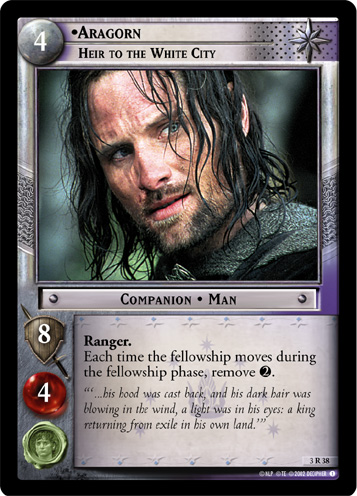
|

|
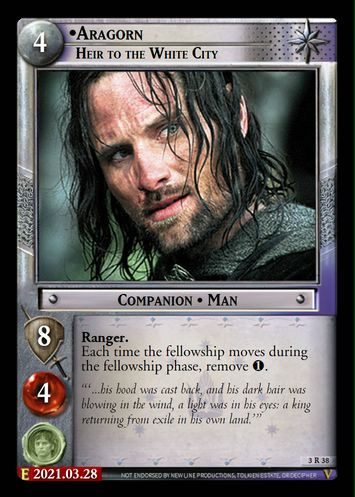
|
There is no cultural enforcement on the game text of this card. This level of permanent resource denial undermines the Shadow number curve on sites. | Here he is, the big man himself. There have been dozens of proposals for the best way to hit ol’ Hair of the White Creepy right in the kneecaps, and the PC went back and forth for a long time. In the end, we’ve got a simple numeric nerf. 1 twilight is not a lot, and considering that it only works on twilight from cards that you played that Fellowship phase, you will probably be better served by using other Aragorns.
Please. We’re begging you. |
Bill the Pony (3U106)
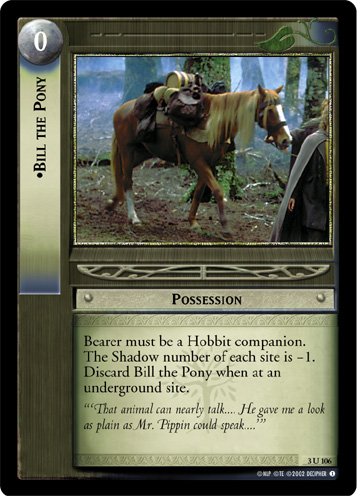
|

|
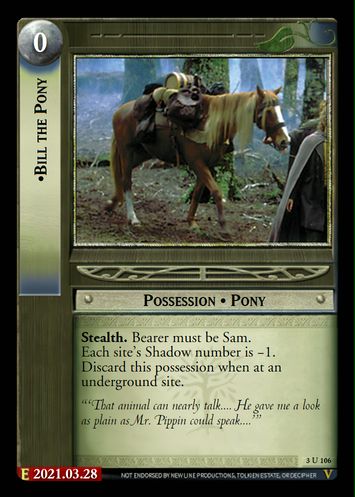
|
Bill the Pony – Choke appears to be a major focus of the X-list. Why? What is it about cards like Bill that make them prime candidates for the list?
Trevor: Resource denial has proven to be a huge issue with Lord of the Rings TCG. Geoff: I think the most important thing to note here is that when people play card games, we actually want them to be able to play their cards. It’s one thing if passive denial (playing little to no cards) leads to a small pool of resources for your opponent. It’s another thing entirely if active denial (playing cards that reduce the opponent’s resources) is forcing an opponent’s entire deck to shut down. Unfortunately, in the system we have, your Free Peoples ‘choke’ strategy does more than just hinder your opponent’s Shadow strategy. It hinders their deck’s cycling…in turn hindering their Free Peoples strategy’s ability to handle your own Shadow strategy. It has a very negative cyclic effect that many players can’t fathom a way out of once they’re stuck in it. |
Decipher here simply mentions the problems with choke in general, as opposed to specific problems that make Bill worthy of getting singled out. They do later mention that at least Talent For Not Being Seen requires more than just Frodo, and so we’ve taken that logic at face value.
Bill’s errata here is designed to kill two birds with one stone: first, by requiring it go on Sam, the lore nerds in all of us are finally satisfied. ….what, did you need a second reason? Well in that case, notice that this can no longer be used in a solo Frodo context, nor can Bill be bounced around between whichever hobbits happen to be the least expendable at the time. Sam in general should end up as less of a pump-n-dump, which should continue to make Son of Hamfast a tiny bit worse. Just a little. |
Ottar, Man of Laketown (1R80)
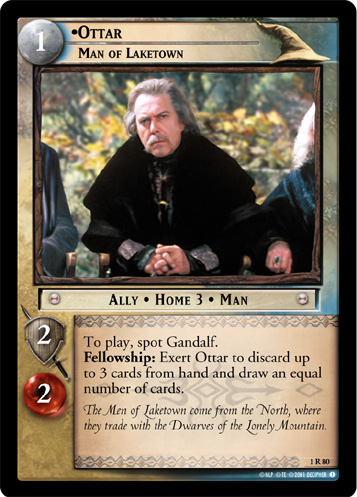
|

|
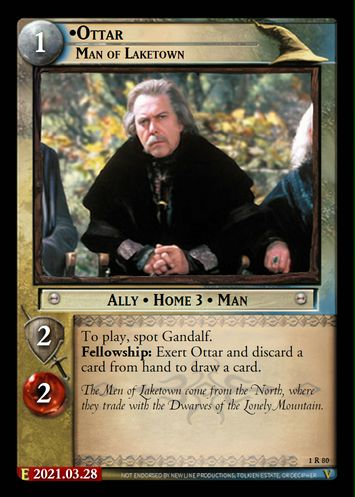
|
This card makes large-scale card draw too accessible to all Free Peoples strategies. It requires a very low cultural commitment to a culture that is not supposed to be the strongest at Fellowship phase card draw. | The complaint is straightforward: it permits lots of card draw (and card cycling, even if that goes unmentioned) when Gandalf is not supposed to. He’s even worse with Elrond, Lord of Rivendell, whose Home 3 healing ensures that Ottar + Elrond permit a 4 card draw / 3 card cycle every Fellowship phase, which makes most other methods pale in comparison.
Our errata is equally straightforward: knock Ottar down to essentially an out-of-phase reconcile once per turn. |
Relics of Moria (1R195)
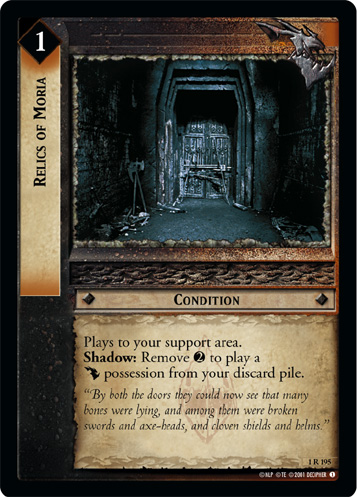
|

|
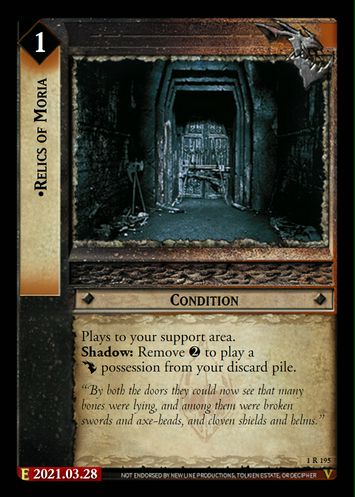
|
Relics of Moria – I’m sure there are a lot of people who would be glad to see less of Moria in the coming year, but most would not have considered this the lynchpin of the deck. What prompted this card being added to the X-list?
Trevor: We knew going into this that Relics of Moria would be the most controversial decision to be included on the list. Moria is an incredibly popular strategy for players the world over. Removing something that players are accustomed to including in every Moria deck is bound to stir some controversy. But the bottom line is Relics is far too efficient, it just does too much. Moria can still do what it did before; the goal wasn’t to kill Moria. But now they have to work at it, a permanent way to start the cycle was just too much. Geoff: The core of Moria is its ability to extend the Shadow player’s hand. That theme was never really expanded upon after FotR was released for obvious reasons: too much of a good thing can be bad. Without the Goblin Scimitar (1C180)
They Are Coming (1C196)
|
Relics is one card that doesn’t seem to match Decipher’s analysis so much. Even in FOTR where it is permitted, it seldom seems to kick-start the Moria twilight engine, which instead is usually triggered by Goblin Scavengers (1C179)
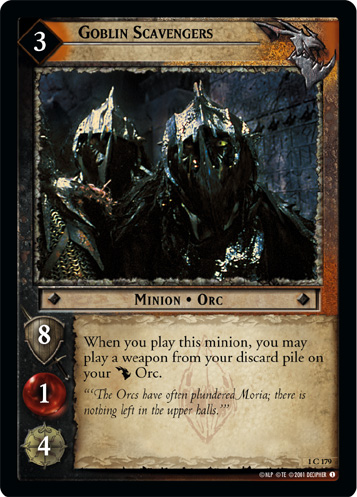 –either played from hand, from Goblin Swarms (1R183)
–either played from hand, from Goblin Swarms (1R183)
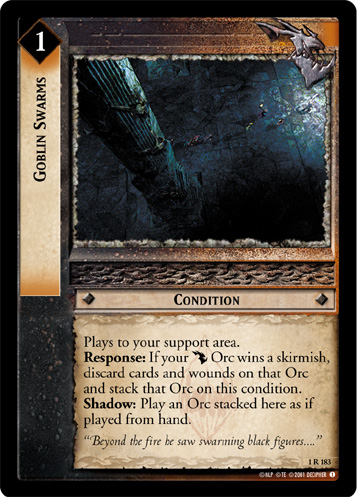 , Hosts of Thousands
, Hosts of Thousands
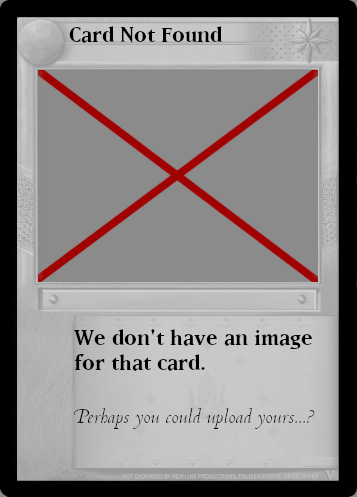 , or They Are Coming (1C196)
, or They Are Coming (1C196)
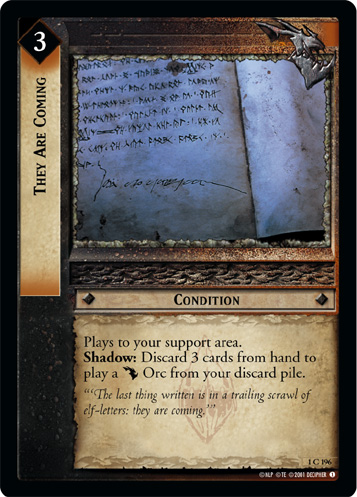 . Far more often Relics is used in a secondary respect to pull weapons that Scavengers can’t get–Cave Troll’s Hammer
. Far more often Relics is used in a secondary respect to pull weapons that Scavengers can’t get–Cave Troll’s Hammer
 , for instance.
, for instance.
In this case the PC has decided to experiment with releasing it with the game text unchanged. Instead, the card is given a very slight nerf by making it unique. This isn’t likely to have much of an impact, but then if we’re right, neither will re-releasing the card. |
Saruman's Snows (1C138)
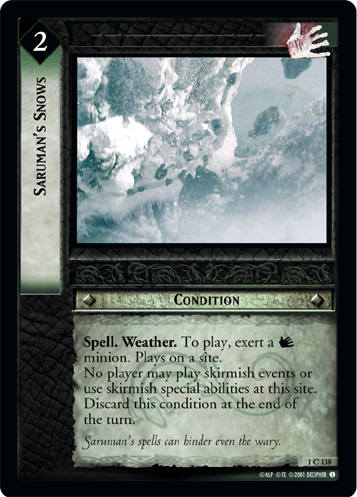
|

|
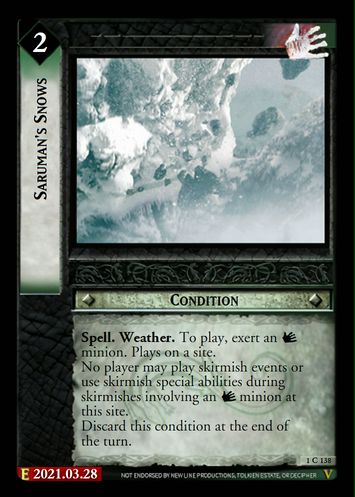
|
This card had perhaps a slower rise to power than some, but before long players knew this was one of the most effective conditions in the game. Its impact was so deep, more than one top-level tournament deck has been seen stocking multiple copies of Boromir's Cloak (1U98)
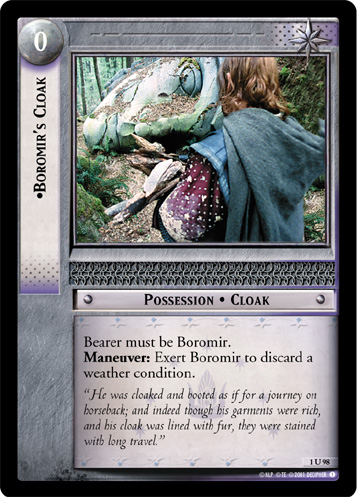 exclusively to deal with it. For a “swarm” style of Shadow strategy, quite potent enough on its own, Saruman’s Snows ensures the Ring-bearer will be overwhelmed.
exclusively to deal with it. For a “swarm” style of Shadow strategy, quite potent enough on its own, Saruman’s Snows ensures the Ring-bearer will be overwhelmed.
Saruman’s Snows does not necessarily interact directly with any of the new rules in Shadows. We have witnessed over the years, however, that it is a figurative mallet where a scalpel is called for. Denying an opponent a resource or opportunity he was counting on is of course what the game is all about. A missed chance to heal here, a lost special ability there; in the right quantities, these are the things meant to decide games. But Saruman’s Snows is a card able to cut off an entire phase of the game – neither skirmish special abilities nor events can slip by it. Consequently, it’s a constant impediment to new card design. In a way, it doesn’t matter how interesting or impactful a new card we release is – if it happens in the skirmish phase, there’s a frequently used card out there that can shut it off. You may well see aspects of this card reappearing in the future, but not all together in a gift-wrapped single package like this. |
Snows is a card that sits at the center of a small cluster of instant-kill strategies: put down Isengard Warrior (3U61)
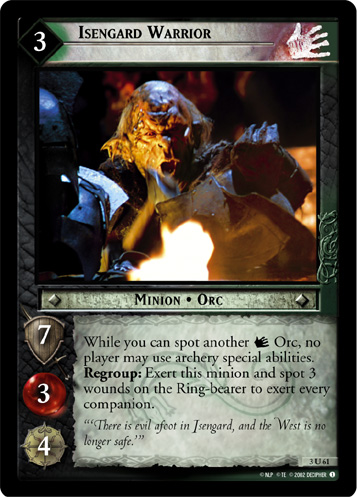 and another Isenorc, play Snows, and then 4-5 other minions: boom, instant overwhelmed Frodo. No archery abilities can be used to thin the herd of minions, and all the ways you might keep Frodo alive (Power According to His Stature (1R308)
and another Isenorc, play Snows, and then 4-5 other minions: boom, instant overwhelmed Frodo. No archery abilities can be used to thin the herd of minions, and all the ways you might keep Frodo alive (Power According to His Stature (1R308)
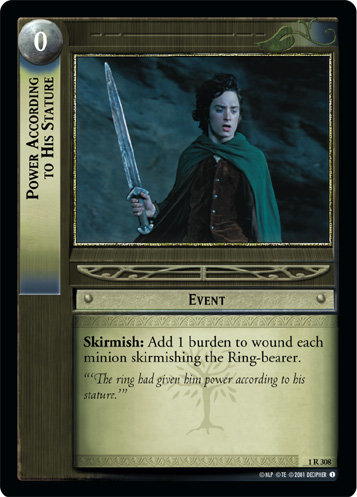 , Hobbit Stealth (1C298)
, Hobbit Stealth (1C298)
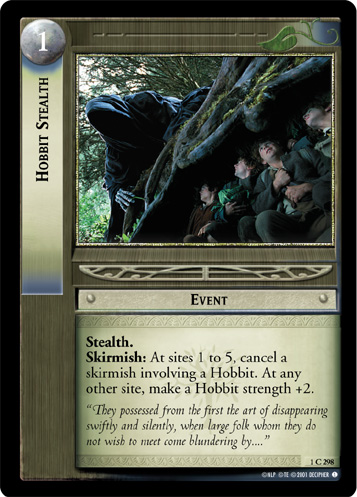 , Boromir, Son of Denethor (1U97)
, Boromir, Son of Denethor (1U97)
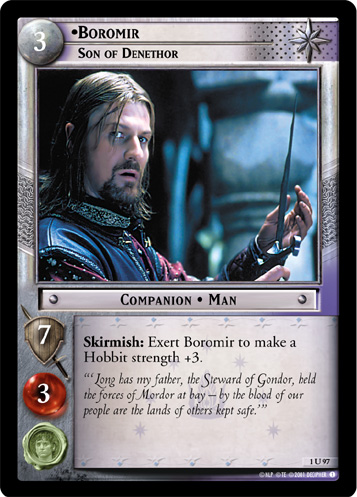 , Merry, Friend to Sam (1R302)
, Merry, Friend to Sam (1R302)
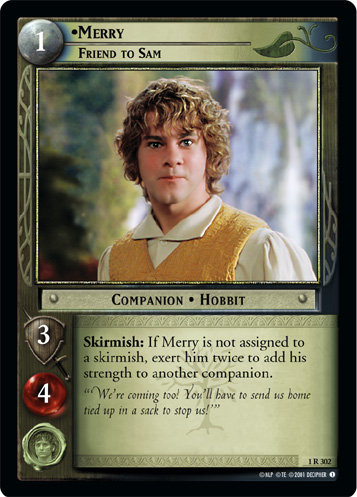 ) can’t be used. The only defenses available are cards that trigger during the Maneuver phase, because all other phases have been systematically denied you.
) can’t be used. The only defenses available are cards that trigger during the Maneuver phase, because all other phases have been systematically denied you.
Snows is also powerful within more general strategies that aren’t attempting a Stupid Swarm insta-kill, but it’s the straightforward power of the insta-kill that really needs addressed. Thus, our errata addresses that specific use case without touching any others. Stupid Swarm relies on having a variety of cheap minions (mostly Moria), with a limited number of Isengard Orcs in the mix. By making Snows only apply to those Isenorcs, it should be possible for the Free Peoples player to assign those few that remain away from the Ring-bearer, leaving Frodo available to use any of the tools in his toolbox to avoid a gristly death. |
Savagery to Match Their Numbers (1R139)
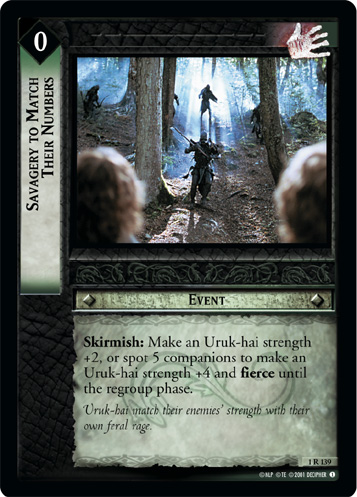
|

|

|
The secondary function of this card is too strong for its cost, and makes the card superior in almost all situations to any other strength event. | Savagery has long been a power card that requires the Free Peoples player to play around in FOTR block. Most anti-Fellowship-size cards are at the 6 companion limit, but Savagery triggers at 5, meaning that fellowships have to either go with a meager 4 companions or risk losing a couple companions anyway to one instance of this card.
The PC has opted to keep the 5 companion spotting element and eliminated the +4 strength boost that lingers to the Regroup phase as the most frustrating aspect of the card. Fierce is scary, but not as scary as one event automatically winning the fierce skirmish for you by dint of the +4 persisting. |
Úlairë Nertëa, Messenger of Dol Guldur (1U234)
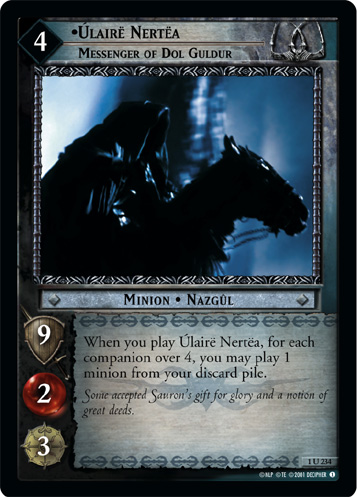
|

|
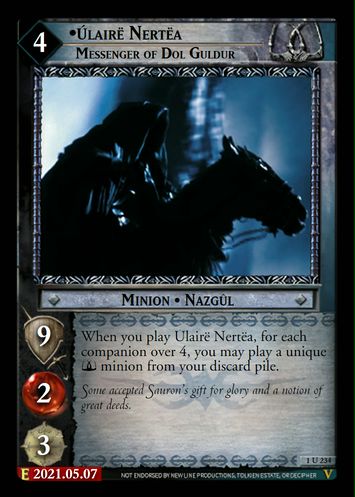
|
The special ability of this card has no cultural enforcement. This makes him too accessible to non-Ringwraith swarm decks. His ability also empowers the swarm by triggering the “best option” swarm minions repeatedly. | There’s not a great option available to nerf Nertea without entirely eliminating his ability to integrate with multicultural Swarms of any flavor (although if you think you’ve cracked the code, let us know). With that, we simply bid farewell. Nertea may well see use in Ringwraith Orc applications, but his days of enabling any deck anywhere are clearly over. |
Forces of Mordor (1C248)
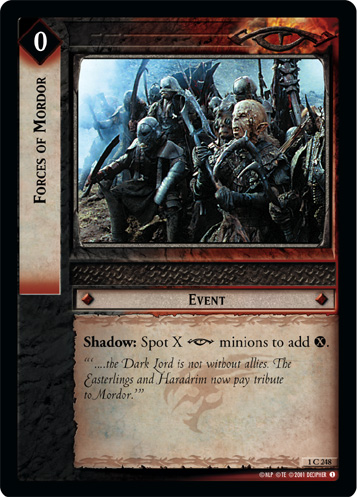
|

|
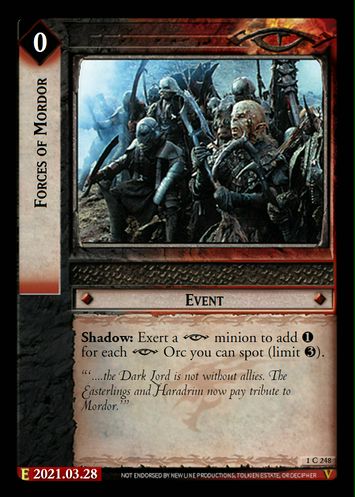
|
This card was written before the swarm dimension was added to the Sauron culture. As such, it is too powerful in those decks. | Forces of Mordor wasn’t really ever much of a problem in FOTR, but later incarnations of Sauron could use this to squeeze out an extra minion or two to powerful effect.
We’ve added an exertion cost and a limit to the output (3 should be enough for one small minion), and ensured it doesn’t trigger off of Troll swarms. The card is likely to be powerful regardless, but we’ll keep an eye on it and adjust it further if warranted. |
Bill Ferny, Swarthy Sneering Fellow (2R75)
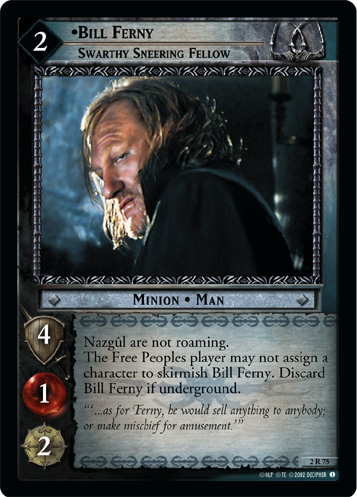
|

|
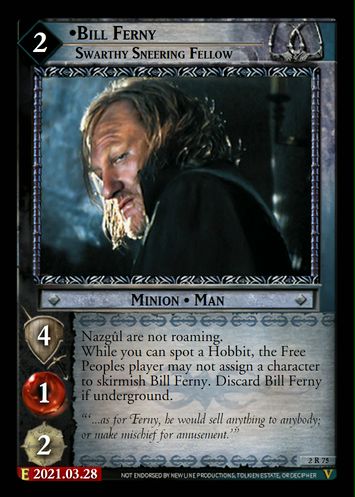
|
There was talk of adding Bill Ferny to the X-List while we worked on Reflections. Clearly, he works well against the alternate Ring-bearers and deters some players from using them. But at that time, we felt that the scales were not tipped far enough against the new Ring-bearers to warrant removing Ferny.
But now Shadows gives resistance a much larger role in the game, and the fact that Ring-bearers other than Frodo have a lower resistance is becoming a greater liability in and of itself. That new liability, combined with the existence of Bill Ferny, threatened to make one of the most well-liked aspects of Reflections too unreliable in a tournament environment for most players to consider. Also, as one more strike against Bill Ferny (though an unneeded one), Shadows introduces a couple of new cards to the Wraith culture (renamed from the Ringwraith culture) which, because they work for the whole culture and aren’t Nazgûl specific, would have made Ferny a truly frightening force to be reckoned with. |
Simply put, Bill Ferny is a nightmare for Alternate Ring-bearers that take wounds or burdens when assigned to a skirmish, since Bill can saunter on up and trigger those deleterious effects whenever he feels like it.
The errata ensures that the self-assign only works if Frodo is around, or if you’ve brought Sam, Son of Hamfast (1C311)
|
Galadriel, Lady of the Golden Wood (3R17)
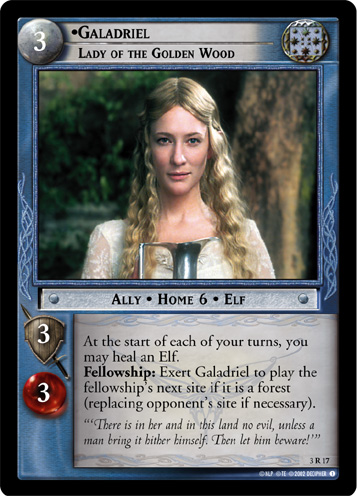
|

|
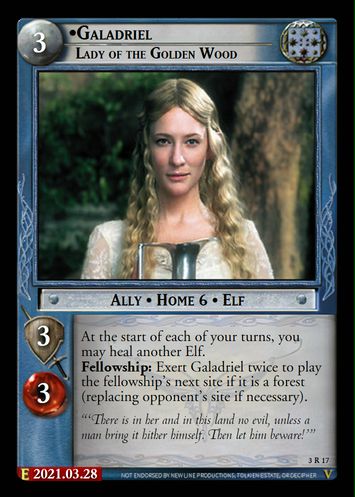
|
Again, terrain is hugely important beginning with Shadows. And as with Gimli, this card was both too strong and out of culture. Pathfinding has never been a part of the Elven culture aside from this card, and suddenly Galadriel was enabling Elves to put out an uninterrupted string of forests onto the adventure path. She could even do this for free, since the cost of her exertion could be negated by using her to heal herself. | One wonders at this point if perhaps it’s the title of “Galadriel” that needs nerfed rather than any other aspect of the card. Regardless, the Big G was a problem for the Shadows path more than anything. To reduce her ability to trigger literally every turn, her ability has been turned away from herself so that she cannot self-heal, and requiring her to exert twice. Now if you want to abuse her site manipulation, you’ll have to pack other means of healing. |
The Palantír of Orthanc (3R67)
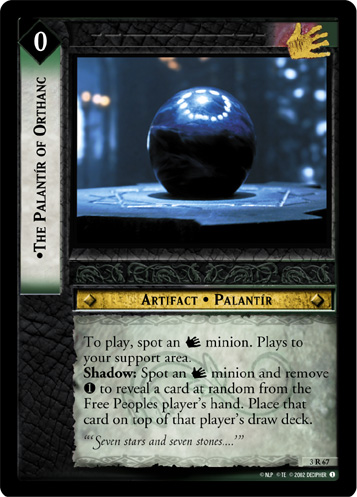
|

|

|
The Palantir of Orthanc – Many people have been calling for this to be added to the X-list for months. In fact, it was highly rumored that it would be added last fall in anticipation of Return of the King and the Initiative mechanic. Why add it now and not then?
Trevor: The Palantir just offered a huge level of control for a player. They were able to control the tempo of the game for their opponent and that is not a good thing. There are a few Initiative strategies out there than can abuse the Palantir and that is something we really want to curb. What strategies do you think this will open up for the Free Peoples? Geoff: Supposedly, events will become more playable…so that means event-driven strategies like PATHS Hobbits, all-Dwarven fighting, and All-elven fighting will get a bit of a boost. Tom: It should free up their ability to include a few more events in their decks. That should open up deck building a little bit, but it is really up to the players to explore exactly what that means. Trevor: I agree that it should really open deck construction for the Free Peoples player. Not having to worry about the Palantir will be a nice change when building a deck. |
Two main issues with this Palantir: first, it interacts negatively with initiative, and second it slows the game down tremendously while your trolling opponent puts all of your cards back on top of the deck one at a time.
The cost of the action has been increased to 2, and you now must have 2 |
Frying Pan (3C108)
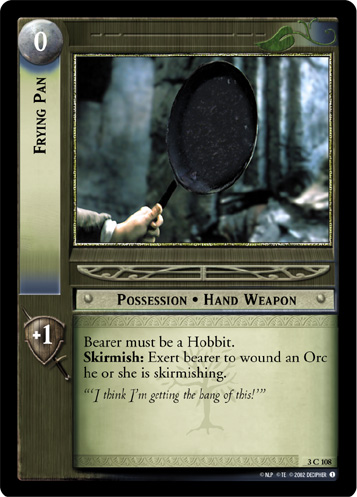
|

|
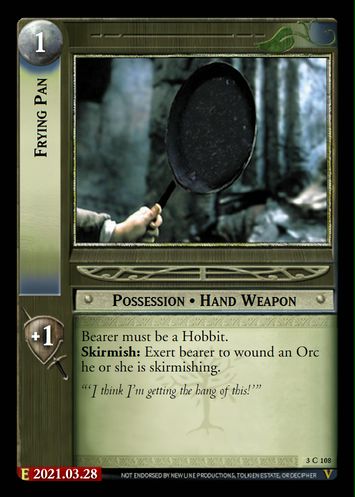
|
Frying Pan – A great deal of people use this card as the be-all and end-all of anti-Moria cards – why add it to the X-list when Moria is still so prevalent at tournaments?
Tom: It is just way too easy. The cheapest resource in the game is Hobbit vitality, and to be able to translate that directly into wounds is just too much. It really hampers a lot of things that we would like to see people be able to do. At the same time, you are right about Moria, so this change couldn’t happen in isolation. Trevor: This card just fits all of the criteria when considering a card for the X-List. The Pan is under-cost, not enforced, and you must take it into account when building a shadow strategy based around orcs. It is also an automatic choice for just about every deck. Geoff: The ‘pan’ was created as an over-compensating answer to the Moria ‘swarm’ strategy (as if there’s some other kind of Moria strategy…well…I say that almost in jest), and when I say over-compensating, I mean it should’ve only affected Moria and no other type of Orc. In the long-term, it’s having a negative impact on every other non-Moria Orc strategy (probably with the exception of Isengard) that relies on 1 and 2 vitality minions. A new balance will evolve between ‘non-pan’ fellowships and ‘non-relics’ Moria decks in the future. |
There’s the usual reasoning of lack of cultural enforcement and undercosting, but reading between the lines a bit, it almost seems like Pan was banned as compensation for Relics also getting banned. We’re letting Relics off lightly, and so we may as well do the same for Pan, with a 1-twilight cost to give it a little impact when it gets tossed between Hobbits. Orcs are bigger and badder than they were when the Pan was removed, and 1-vitality Moria swarms are less prevalent, so as far as we can tell this shouldn’t be as big of an issue. We’ll keep an eye on this one just in case. |
Filibert Bolger, Wily Rascal (2C101)
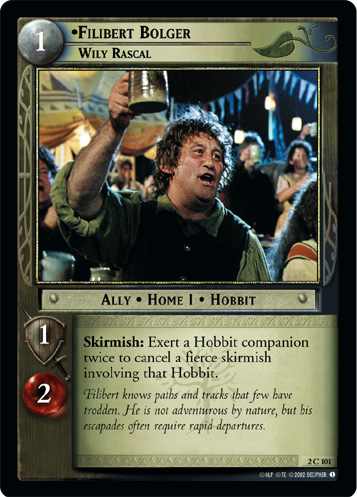
|

|
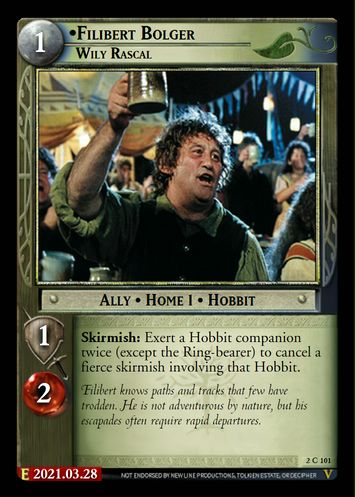
|
There is no cultural enforcement on this card as all players have one or more Hobbits. For a special ability on a permanent, the cost is too low compared to the power provided. Also, this is a permanent that cancels the Ring-bearer’s skirmish at site 9. | Short and sweet. Filibert keeps Frodo from dying at site 9, so we will prevent him from being able to use it. This should relegate Fatty to Hobbit-only decks as a result. |
O Elbereth! Gilthoniel! (2R108)
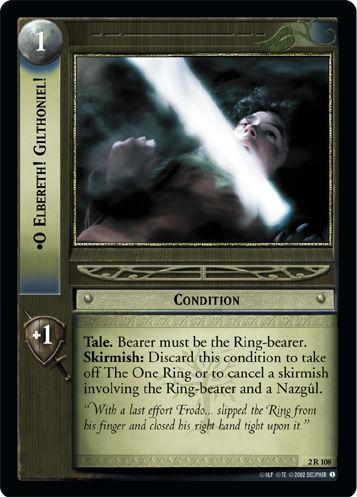
|

|
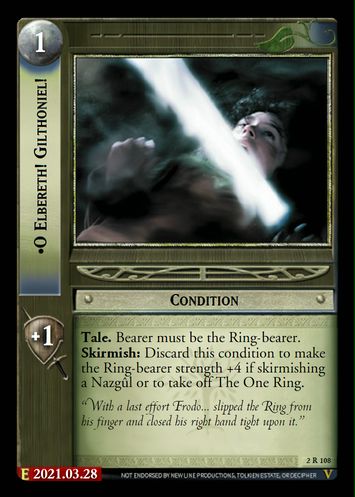
|
There is no cultural enforcement on this card as all players have a Ring-bearer. Also, this is a permanent that cancels the Ring-bearer’s skirmish at site 9. | Another site-9 game winner. Rather than auto-winning the skirmish, we’ve opted to make it so the Ring-bearer can survive the skirmish instead. +4 strength will permit a naked Frodo to survive against any Nazgul except the Witch-king (fittingly), and depending on which version of the One Ring is used, he might even survive that. |
The Shire Countryside (3R113)
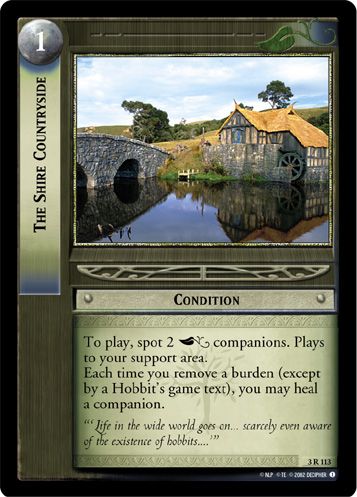
|

|
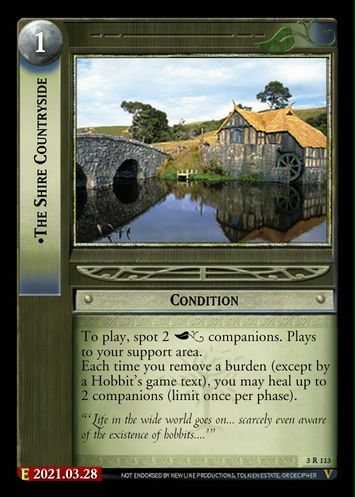
|
(As far as we can tell, Decipher never recorded their reasoning behind why they burned down The Shire Countryside) | ...but we can make some educated guesses.
Really, it’s got to come down to the ease of which this can be used to just wipe the whole board of wounds. Shire is already among the only cultures that are able to handle burdens, but the ease with which that burden removal can be turned to healing means that often Frodo will intentionally load up on more burdens than he needs just to be able to fuel the healing engine. That’s clearly over the line. Here, we’ve made the card unique (preventing 4x stacking) and placed a phase limit on the trigger to keep it from being so gratuitous. To compensate, one burden can now be used to heal two separate companions, meaning that if you want to take advantage of what the Countryside has to offer, you’ll have to take a leisurely stroll rather than a mad dash. |
| Card Name | Old Version | PC Errata | Decipher Errata Reason | PC Notes |
|---|---|---|---|---|
Legolas, Dauntless Hunter (4R73)
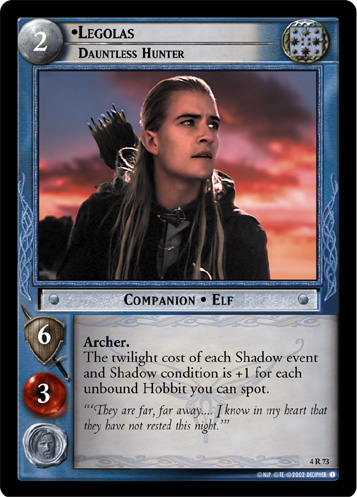
|

|
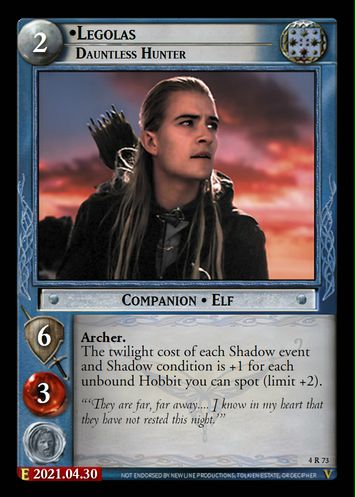
|
One can look at deck lists before and after The Two Towers expansion and see a sudden, sharp drop in the number of conditions used by the average Shadow build, a trend which to this day many Shadow strategies don't dare to challenge. Playing against a Dauntless Hunter deck can be particularly negative to a new player, who is usually unaware that such a powerful deck type exists to stall playing Shadow events and conditions.
In Expanded formats, 5 different unbound Hobbits are there to add to Merry and Pippin, and push the power of this Legolas to the max. I don't think conditions and events clocking in at a total of 7 twilight would be the greatest playing experience. |
PC Notes here |
Uruk Regular (4C192)
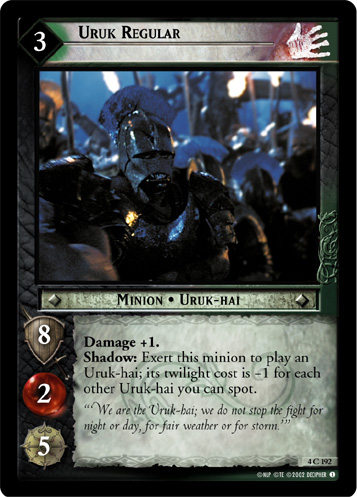
|

|

|
Decipher justification here | PC Notes here |
Fortress Never Fallen (4U276)
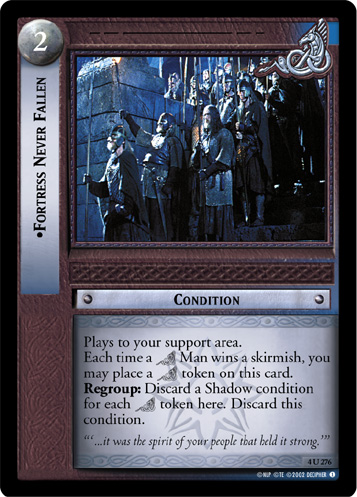
|

|

|
Decipher justification here | PC Notes here |
Get On and Get Away (4R304)
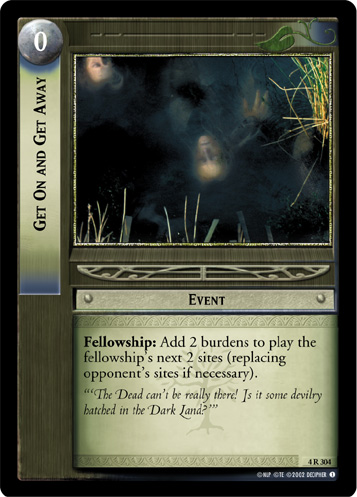
|

|

|
Decipher justification here | PC Notes here |
Steadfast Champion (7U49)
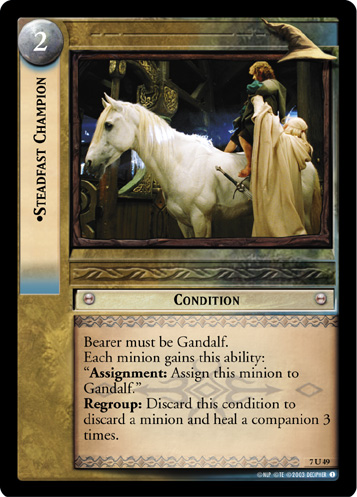
|

|
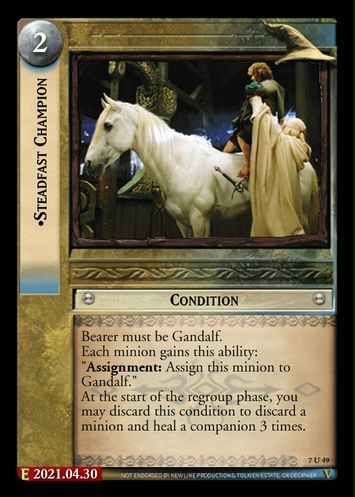
|
Decipher justification here | PC Notes here |
Gondorian Captain (7C96)
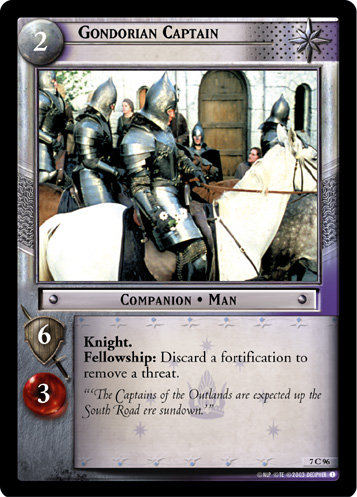
|

|
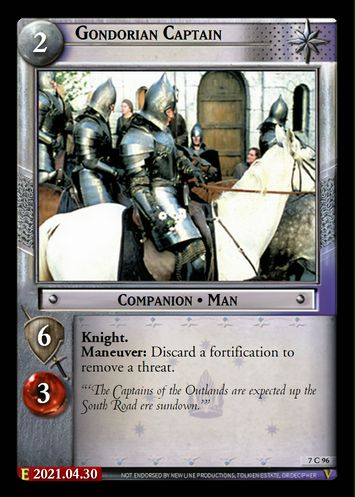
|
Decipher justification here | PC Notes here |
Aggression (8C1)
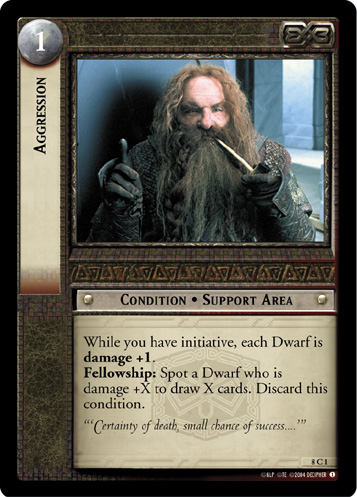
|

|
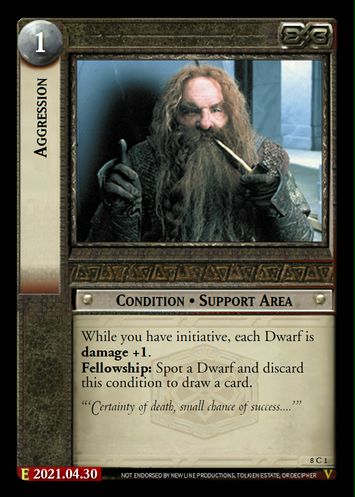
|
Decipher justification here | PC Notes here |
Memories of Darkness (10U2)
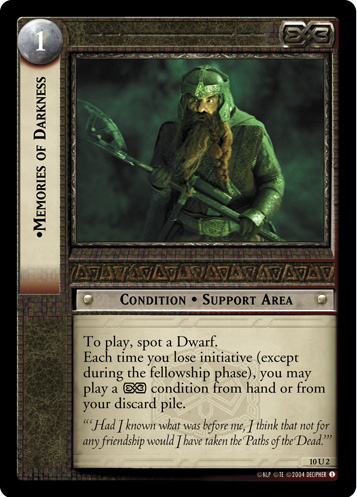
|

|
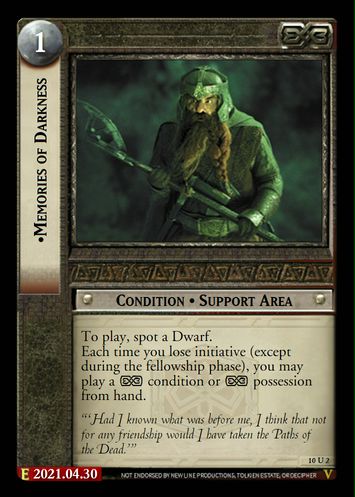
|
Decipher justification here | PC Notes here |
Galadriel, Lady Redeemed (10R11)
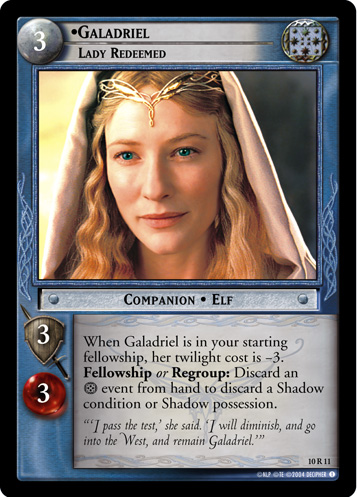
|

|

|
Decipher justification here | PC Notes here |
Mordor Fiend (10C91)
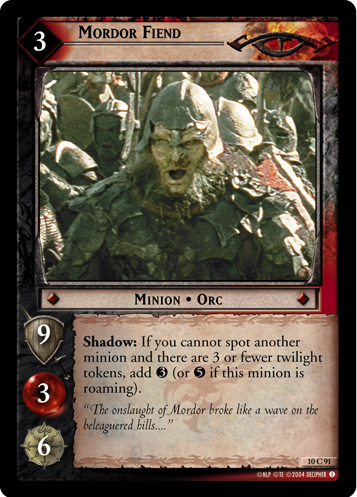
|

|

|
Decipher justification here | PC Notes here |
| Card Name | Old Version | PC Errata | Decipher Errata Reason | PC Notes |
|---|---|---|---|---|
Final Account (11C31)
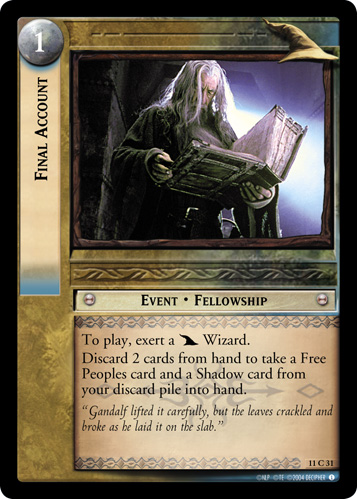
|

|
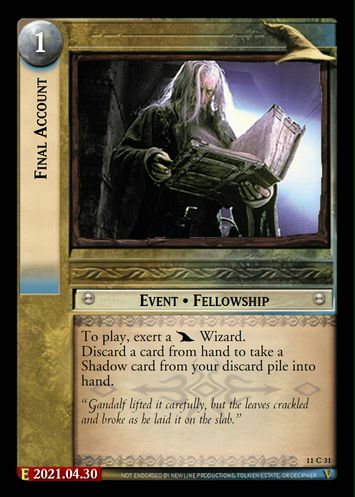
|
Decipher justification here | PC Notes here |
Strange-looking Men (11R100)
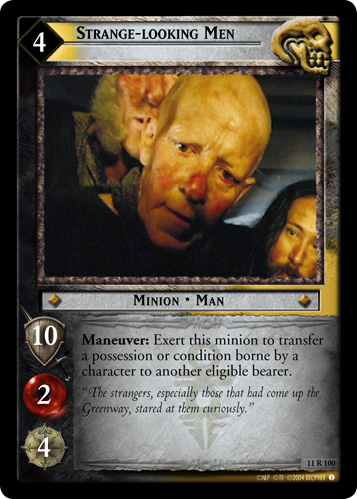
|

|
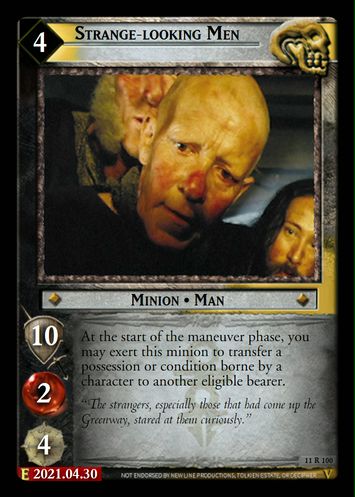
|
Decipher justification here | PC Notes here |
Demoralized (11U114)
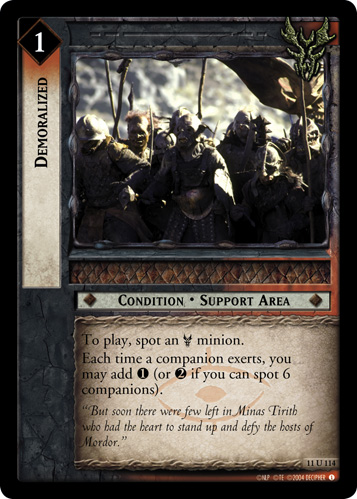
|

|
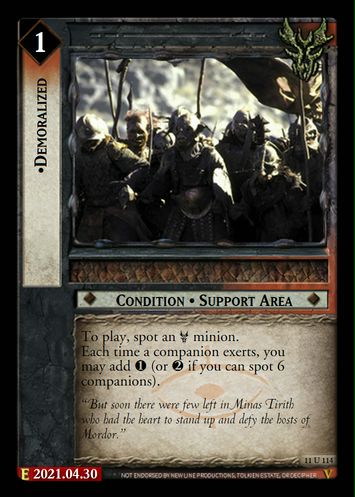
|
Decipher justification here | PC Notes here |
Orkish Smith (11C132)
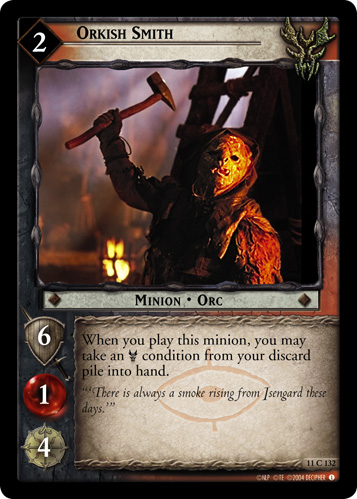
|

|
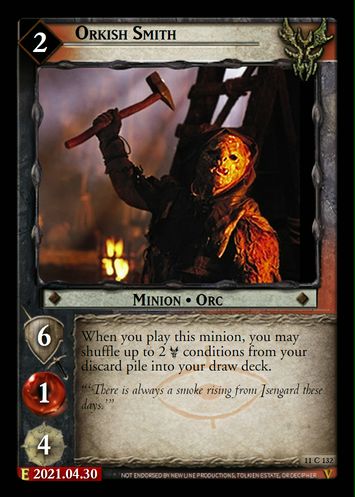
|
Decipher justification here | PC Notes here |
Courtyard Parapet (13U188)
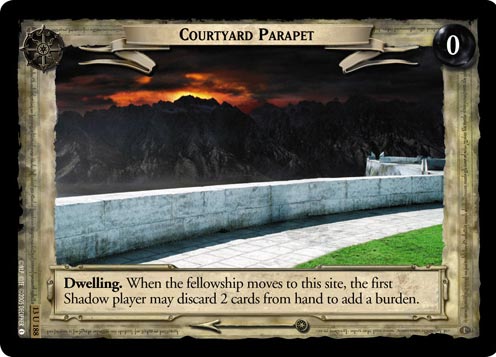
|

|
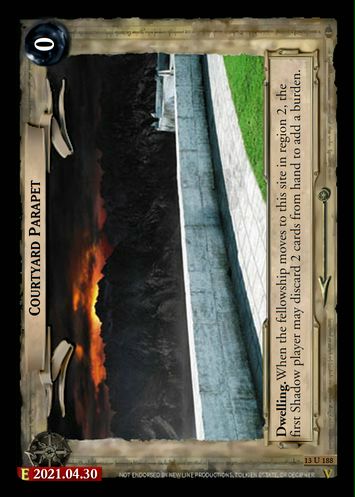
|
Decipher justification here | PC Notes here |
Madril, Defender of Osgiliath (15R64)
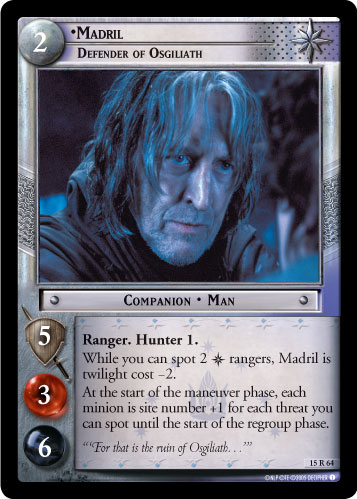
|

|

|
Decipher justification here | PC Notes here |
